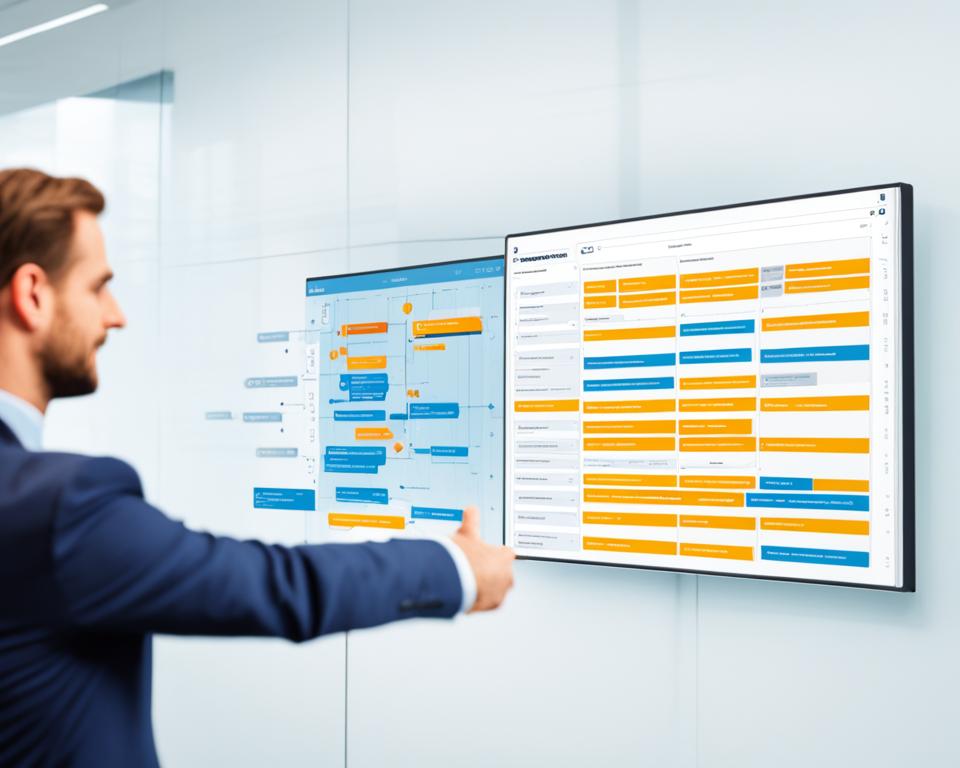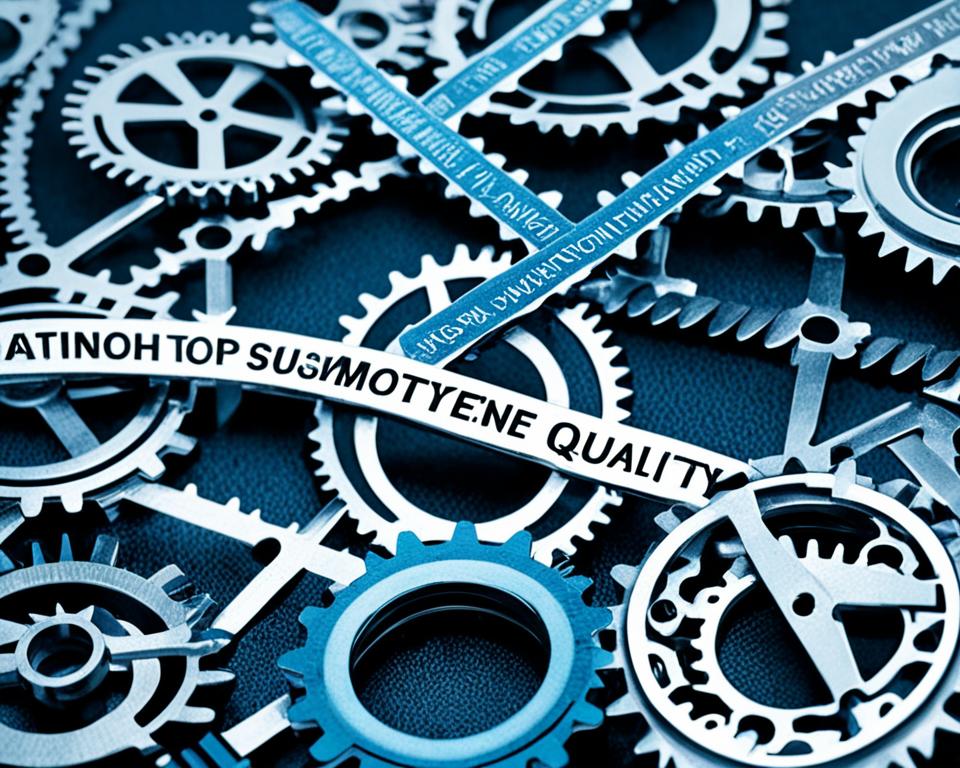Have you ever thought about why some companies always make high-quality products? Others seem to struggle with keeping up. It’s often because they don’t use good Quality Management practices. SAP QM can change that. It helps make quality control and checking products better. By using SAP QM, companies can improve how they manage quality and meet high standards. Let’s look at what SAP QM is and why it’s important for quality in different industries.
Key Takeaways
- SAP QM plays a vital role in optimizing quality management workflows.
- Effective quality control is essential for maintaining product excellence.
- Quality management impacts compliance and overall business performance.
- Implementing SAP QM can significantly reduce inefficiencies.
- Understanding key features of SAP QM enhances product inspection processes.
Understanding SAP Quality Management
SAP QM is a key part of the SAP ERP system. It helps manage quality assurance and control processes. This tool makes sure products meet customer and regulatory standards. It helps make operations more efficient and lowers the risk of poor quality.
What is SAP QM?
SAP QM is the Quality Management module in SAP ERP. It handles quality planning, inspections, and control. It keeps track of all quality activities, making sure products and processes meet standards.
This module helps companies keep detailed records and assessments. It makes quality management easier and more efficient.
The Importance of Quality Management
Quality management is very important. It leads to happier customers and builds trust, which means better brand loyalty. It also helps find and fix inefficiencies, cutting down on waste and costs.
By focusing on quality, companies can lower risks and improve their market position.
Key Features of SAP QM
SAP QM has many features that make quality management better in companies. It focuses on quality planning and control, and tracking defects.
Quality Planning and Control
In SAP QM, quality planning helps set up specific quality needs and inspection plans. The main points are:
- Defining inspection plans that match product specs.
- Setting quality criteria to meet industry standards.
- Creating quality inspection types for different production stages.
This makes it easier to keep products up to quality standards, reducing defects and quality issues.
Defect Tracking Capabilities
Tracking defects is key for quality management. SAP QM has tools for:
- Recording and tracking defects at all production stages.
- Looking into defect patterns to find the main causes.
- Fixing quality problems quickly.
This method not only boosts product quality but also helps plan for better quality in the future.

| Feature | Description | Benefits |
|---|---|---|
| Quality Planning | Setting up quality needs and inspection plans. | Keeps up with standards; cuts down on defects. |
| Defect Tracking | Tracking and monitoring defects during production. | Speeds up fixing issues; betters future planning. |
SAP QM for Quality Assurance
SAP QM is key to better quality assurance. It automates routine tasks, cutting down on manual work and errors. With advanced data analysis, I can spot trends and issues fast, leading to better quality management.
Enhancing Quality Assurance Workflows
Using SAP modules helps streamline operations. SAP QM makes it easier for departments to talk to each other, improving quality checks. By automating tasks, I can focus more on making big decisions. This leads to better products and lower costs.
In short, SAP QM makes quality assurance more efficient by:
- Automating data collection and analysis
- Enhancing collaboration across teams
- Providing real-time insights into quality metrics
Integrating SAP QM with Other Modules
When SAP QM works with other SAP modules, like production planning and inventory, it gets even stronger. This flow of info creates a unified quality management system. With all the data at my fingertips, I can make smarter decisions that meet business goals.
This integration brings big benefits, such as:
| Integration Aspect | Benefit |
|---|---|
| Real-time Data Sharing | Improved accuracy in quality reporting |
| Cross-Functional Collaboration | Enhanced problem-solving capabilities |
| Automated Workflows | Increased efficiency and reduced cycle time |
Streamlining Quality Control Processes
Quality control is key to keeping production high. SAP QM uses advanced methods to make sure products are up to standard. It also uses statistical process control to make sure products are reliable and consistent.
By looking at data, businesses can spot problems and fix them fast. This keeps quality up and makes sure products are top-notch.
Averaging through Statistical Process Control
Statistical process control (SPC) helps reduce variation and improve quality. It uses tools like control charts to watch how processes change over time. This lets me catch quality issues early.
It also helps me average outputs to get a clear picture of performance. This leads to ongoing improvements in quality.
Real-time Data Monitoring and Analysis
Real-time data monitoring is a big part of SAP QM. It lets me see how things are doing right now and make quick changes. This means I can spot trends and fix problems fast.
Using real-time data and statistical control together makes quality control strong. It’s a solid way to keep products up to standard.
Product Inspection with SAP QM
Product inspection is key in quality management. Using SAP Quality Management, we set up detailed inspection plans. This helps check products at different stages of production. It keeps quality high and makes customers happy.
Setting Up Inspection Plans
Creating inspection plans means listing what and how to check products. Important parts of these plans are:
- Establishing clear objectives – Define the specific goals of the inspection process.
- Identifying inspection points – Determine where inspections will occur throughout production.
- Specifying measurement techniques – Use the right methods to check product quality.
- Documenting results – Keep records to track quality and support audits.
Automation in Product Inspection
Automation makes inspection more accurate and efficient. Automated systems quickly go through data from inspection plans, offering:
- Real-time data processing – Quick feedback on product quality during production.
- Reduced human error – Less chance of mistakes with automated checks.
- Streamlined reporting – Fast reports for better decisions.
- Increased throughput – Automation speeds up inspections, making production smoother.
Adding automation in inspection helps meet quality standards and improve over time. This use of technology in checking products sets the stage for top-notch operations. It ensures quality stays consistent in production.
Supplier Quality Management
Managing suppliers well is key to keeping products top-notch and making operations run smoothly. I check suppliers carefully, using different methods to learn about their skills. This way, I make sure they meet our standards and help the supply chain.
Assessing Supplier Capabilities
It’s important to look at suppliers from many angles. I check on several key things:
- Audits: Regular checks make sure they follow quality rules.
- Performance Metrics: Things like defect rates and timely delivery tell us how well they do.
- Certifications: Having the right certifications means they meet industry needs.
Collaboration with Suppliers for Quality
Working closely with suppliers boosts product quality and supply chain efficiency. Good communication lets us:
- Joint Quality Initiatives: Improving quality together leads to new ideas.
- Feedback Loops: Sharing feedback helps us keep getting better.
- Training Opportunities: Giving training and resources lifts their skills.

By focusing on managing suppliers and working together, I make sure the supply chain runs well. This leads to better products and happy customers.
| Assessment Method | Description | Benefit |
|---|---|---|
| Audits | Comprehensive evaluations of supplier practices. | Ensures compliance with standards. |
| Performance Metrics | Analysis of key performance indicators. | Uncovers areas needing improvement. |
| Certifications | Verification of industry-related certifications. | Guarantees adherence to industry standards. |
| Joint Quality Initiatives | Collaborative quality improvement projects. | Encourages innovation and efficiency. |
Regulatory Compliance and SAP QM
For businesses, sticking to the rules is key, especially in fields like pharmaceuticals and food safety. SAP QM helps companies manage quality well, meeting tough legal standards. This software cuts down on compliance risks and boosts a company’s good name.
Ensuring Compliance in Quality Management
SAP QM makes quality management easier by automating processes. It’s crucial for following rules set by the U.S. Food and Drug Administration and the International Agency for Standards.
- Real-time monitoring of quality metrics to ensure standards are upheld
- Automated reporting functionalities to document compliance efforts
- Guidelines for developing thorough quality audits
These features help companies stay ahead in following the rules. Using SAP QM sets up strong ways to keep track of and report on compliance. This lowers the chance of not meeting standards.
| Compliance Aspect | SAP QM Features |
|---|---|
| Real-time Monitoring | Dashboards for live tracking of quality metrics |
| Audit Management | Automated documentation and reporting tools |
| Risk Assessment | Tools for identifying and mitigating compliance risks |
| Reporting | Comprehensive reports aligning with regulatory standards |
In conclusion, my experience with SAP QM shows its big role in quality management compliance. It gives companies the tools to smoothly handle complex compliance rules.
Non-Conformance Management
Managing non-conformance is key in any quality system. It helps spot and fix any issues during production or with final products. With SAP QM, I can keep track of quality problems and start fixing them. The goal is to make quality better and keep improving.
Identifying and Managing Non-Conformance
First, we find issues that don’t meet quality standards. SAP QM helps me track defects and record non-conformances well. Keeping things organized is important for later review.
Regular checks help spot quality problems early. This helps us understand and fix recurring issues better.
Developing Corrective Actions
After finding non-conformances, it’s crucial to take action. I look into each issue to find the root cause. Then, I plan steps to stop it from happening again.
Actions can be anything from changing a process to training staff. Having a clear plan makes sure everyone knows their role. It also helps us check if our actions are working and adjust as needed.

| Quality Issues Identified | Correction Method | Status |
|---|---|---|
| Defective Material Used | Supplier Evaluation | In Progress |
| Process Variance | Process Re-engineering | Completed |
| Insufficient Training | Enhanced Training Program | Scheduled |
Quality Metrics for Enhanced Performance
Quality metrics are key to checking how well a business is doing. They give clear signs of how well an organization works. Knowing these metrics helps me focus on areas to improve. Tools like SAP QM help set and use quality metrics that fit our business needs.
Defining Key Quality Metrics
For SAP QM, picking the right quality metrics is vital. It helps spot areas that need betterment. Important metrics include defect density, yield, and customer satisfaction scores. These show how well we’re doing and guide us in making things better. For example:
| Quality Metric | Description | Purpose |
|---|---|---|
| Defect Density | Number of defects per unit of measurement | Measures product quality |
| Yield | Rate of acceptable products produced | Evaluates overall efficiency |
| Customer Satisfaction Score | Feedback rating from customers | Assesses service quality |
Tracking and Improving Quality Metrics
Keeping an eye on metrics is key to getting better at what we do. SAP QM’s tracking tools let me watch these metrics closely. By looking at trends, I can spot problems and fix them. Regular checks show us what’s working and what’s not, helping us keep getting better.
For more tips on quality management, I look at resources like this. Getting good at quality metrics means happier customers and a successful business.
Benefits of Implementing SAP QM
Implementing SAP Quality Management offers many advantages for organizations. It helps improve product quality and cuts costs. Using a systematic approach to quality management boosts efficiency and gives a company a competitive edge.
Improving Product Quality
Product quality is crucial for any organization’s success. SAP QM helps with thorough inspections and quality control. It lets companies keep high standards at every production stage.
With real-time quality checks, companies can quickly fix defects. This ensures they meet all the rules and regulations.
Reducing Costs and Redundancies
Lowering costs is key to making more money. SAP QM cuts waste and encourages ongoing improvement. I saw how teams worked better together, cutting costs and saving money.
This isn’t just about spending less. It’s also about managing resources well and improving relationships with suppliers. This makes the whole process more effective.

| Benefit | Description |
|---|---|
| Product Quality Improvement | Ensures high-quality production through rigorous inspections and proactive defect management. |
| Cost Reductions | Enhances operational efficiency, leading to significant savings and optimized resource utilization. |
| Supplier Collaboration | Strengthens supplier partnerships by promoting transparency and quality standards in supply management. |
| Compliance Assurance | Helps maintain adherence to regulations, reducing risks associated with non-compliance. |
Using SAP QM, companies can make better products and set themselves up for long-term success. This powerful tool changes how operations work, making quality a key part of the business plan.
For more details on how SAP Ariba can improve procurement, check out this detailed guide.
Challenges in Quality Management
Organizations often face hurdles in quality management. It’s key to know these challenges to use tools like SAP QM well. Big problems include not having enough resources, not having enough trained staff, and making quality management fit with current processes.
Common Quality Management Challenges
Businesses today deal with many quality management issues:
- Resource Constraints: Not having enough money and people can make it hard to use quality management well.
- Lack of Trained Personnel: If employees aren’t trained in quality control, keeping quality standards up can be tough.
- Integration Difficulties: Making new quality management systems work with old tech is hard.
- Resistance to Change: People might not want to try new ways of doing things, making it hard to improve quality management.
- Data Management Issues: Bad data quality can lead to wrong reports, hurting efforts to get better at quality.
It’s important to tackle these quality control challenges. Companies can look into solutions like SAP Ariba to make buying better and work better together, as shown in real-world case studies. These examples show common problems and ways to get past them in quality management.
SAP QM: Streamline Quality Management Processes
Streamlining quality management processes is key for top performance in many operations. I’ll share steps to do this with SAP QM. These steps include effective setup, thorough training, and getting stakeholders on board. Doing these things boosts productivity and makes quality management stronger.
Key Steps to Streamline Processes
To make processes better in SAP QM, follow these steps:
- Assess Needs: Look closely at current quality management processes to find what’s missing and what can be better.
- Configuration: Set up the SAP QM module to fit your specific needs, making it work for your organization.
- Continuous Training: Offer strong training to employees, focusing on the key parts of SAP QM.
- Stakeholder Engagement: Get key people involved in the setup to build support and encourage teamwork.
- Feedback Mechanisms: Create ways to get ongoing feedback from users to improve processes as needed.
Best Practices for Implementation
For effective SAP QM implementation, follow best practices that make the most of the system. These include:
- Documenting Processes: Keep detailed records of all quality management steps for clearness and consistency.
- Utilizing Automation: Use automation tools in SAP QM to cut down on manual work and boost precision.
- Integrating with Other Modules: Make sure SAP QM works well with other SAP modules for a full view of operations.
- Regular Audits: Do regular checks to see how well things are working and to keep improving quality management.
- Metrics Tracking: Set up key performance indicators (KPIs) to track how well processes are streamlined, helping to make ongoing improvements.

By using these best practices for SAP QM, organizations can make quality management better. This leads to better operational efficiency.
For more on how software helps optimize processes, check out this resource.
Future Trends in Quality Management
The world of quality management is changing fast. Digital tools like artificial intelligence and the Internet of Things (IoT) are becoming key. These technologies are changing how we check quality, helping companies keep up with new market needs and stay ahead.
Embracing Digital Transformation
Companies need to dive into digital transformation. This change makes operations smoother and quality checks more accurate with real-time data. Using tools like Ariba with SAP ERP helps manage spending and improve relationships with suppliers. These changes are crucial for keeping quality high.
Adapting to Industry Standards
Keeping up with industry standards is key to success. Companies must update their quality management to follow best practices and rules. Knowing about new standards helps businesses make sure they follow the rules and keep quality up. Using resources like the Ariba integration shows how to stay on top of quality management.
| Trend | Description | Impact on Quality Management |
|---|---|---|
| Digital Tools Adoption | Using AI and IoT for real-time quality checks. | Makes quality checks more accurate and efficient. |
| Regulatory Adaptation | Following new industry standards. | Keeps companies in line with the law and competitive. |
| Cloud-based Solutions | Using cloud platforms for smoother processes. | Better data management and supplier relationships. |
Case Studies: SAP QM in Action
Looking at real-world uses of SAP QM shows us how it helps with quality management. We see how different companies have made their processes better, improved quality checks, and seen real results. These stories give us lessons to use in the future and help avoid mistakes.
Success Stories of Streamlined Quality Management
Many industries have made SAP QM work for them to better manage quality. For instance, a big car maker used SAP QM to make checking cars automatic. This cut down on mistakes and made the cars better. It also made getting new cars to market faster.
Another example is a food company that used SAP QM to keep an eye on food safety rules. By using real-time data and checking quality at every step, they made sure their food was always good. They also cut down the risk of contamination a lot.
Lessons Learned from Implementations
From these stories, we learn a few key things. First, getting everyone involved when you start makes things go smoother and gets everyone on board. Teaching employees about SAP QM helps them use it well. Talking clearly about the changes helps everyone see how it affects their work.
It’s also important to set clear goals for quality after you start using SAP QM. Keeping an eye on things and making changes as needed keeps getting better. Companies should be open to new ideas, like using ABAP Web Dynpro, to make things better for users and work faster.
| Industry | Key Implementation | Results Achieved |
|---|---|---|
| Automotive | Automated inspection processes | Reduced manual errors, expedited production |
| Food Processing | Real-time monitoring for compliance | Consistent quality, improved safety standards |
| Pharmaceutical | Integrated quality checks throughout production | Enhanced product reliability, regulatory compliance |
These stories show how SAP QM has made quality management better. They teach us lessons for the future, helping companies work better and make better products.
Conclusion
Exploring SAP QM has shown us a powerful tool for improving quality assurance. It helps make workflows better, connects well with other systems, and handles non-conformance well. By using SAP QM, companies can make their products better, cut costs, and work more efficiently.
The changing nature of business means quality practices must also change. Using SAP QM fully means being open to new ideas. This helps companies quickly adapt to new rules and trends, keeping quality management ahead of the game.
In wrapping up our look at SAP QM, it’s clear how vital this system is for quality management. It helps with working with suppliers and checking products. Companies that keep improving these areas can use SAP QM to keep getting better. Staying up to date with these practices is key for success in today’s fast-changing world.
FAQ
What is SAP QM?
SAP QM stands for Quality Management. It’s a part of the SAP ERP system. It helps make sure products are up to customer and regulatory standards.
Why is quality management important?
Quality management keeps products top-notch and processes smooth. It boosts customer happiness, cuts down on quality problems, and helps follow the law.
What are the key features of SAP QM?
SAP QM has quality planning, tracking defects, and reporting tools. These help manage quality across all processes.
How does SAP QM support quality assurance workflows?
SAP QM makes quality workflows smoother by automating tasks. It offers real-time data analysis and connects different SAP modules for better efficiency.
What is statistical process control (SPC) in SAP QM?
SPC in SAP QM uses stats to watch and control processes. It keeps products consistent and reliable.
How can I set up inspection plans in SAP QM?
To set up inspection plans, define what to inspect, when, and how. Use lot management to track results.
How does SAP QM enhance supplier quality management?
SAP QM helps check supplier skills through audits and metrics. It improves teamwork and communication for better products.
What tools does SAP QM have for ensuring regulatory compliance?
SAP QM has tools for following industry laws. It offers workflows, document management, and reporting to keep risks low.
How is non-conformance managed in SAP QM?
SAP QM handles quality issues by spotting and recording them. It takes corrective steps and checks how well they work to keep improving quality.
What are quality metrics, and how does SAP QM utilize them?
Quality metrics are ways to measure performance. SAP QM uses them to set, watch, and analyze these metrics for ongoing quality improvement.
What benefits does implementing SAP QM provide?
SAP QM brings better product quality, more efficiency, cost cuts, and less waste. It boosts business performance and competitiveness.
What challenges are associated with quality management in organizations?
Challenges include not having enough resources or trained staff. It’s hard to blend SAP QM with current systems and keep up with quality standards.
What are the best practices for implementing SAP QM?
Best practices include setting up SAP QM right, training people, engaging stakeholders, and regularly checking quality processes for better use of SAP QM.
How is digital transformation shaping the future of quality management?
Digital changes are key in quality management. They bring in AI and IoT to improve quality, make better decisions, and keep up with new laws.
Can you provide examples of SAP QM success stories?
Yes, many case studies show how SAP QM has helped different industries. They’ve made quality processes smoother, improved quality, and learned important lessons.


